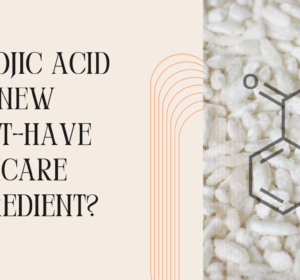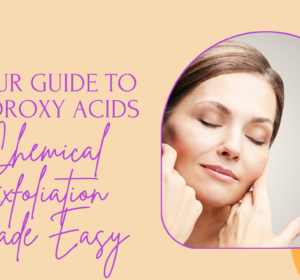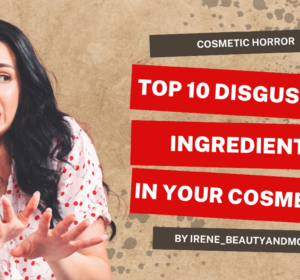If you’ve ever wondered what is in that bottle of sun protection you apply on during your beach days or outdoor adventures, you’ve come to the right place. Sunscreen isn’t just a magic potion that shields you from harmful rays; it’s actually a fascinating mixture of ingredients that work together to keep your skin safe and protected against UV sun radiation. So, if you’re curious about what makes your sunscreen effective and how it keeps those UV rays at bay, stick around! We’re about to unveil the secret sunscreen ingredients. Let’s dive in and get to know the sunscreen superheroes!

What is a sunscreen?
Sunscreens are the most important product in any skincare routine, independent of the season. They protect your skin from the harmful sun radiation. But how do they do that? Well, they can protect your skin in two different ways:
Some sunscreens block any type of sun radiation and that makes them ideal for babies and people with sensitive skin. The problem with these sunscreens is that you will never get tanned. On the other hand, there are other types of sunscreen that only block UV radiation, allowing your skin to get tanned.
These two types of sunscreens have something in common; they contain solar filters among their ingredients. A solar filter is the basic ingredient in any sunscreen.
We can define a solar filter as an ingredient added to a cosmetic product with the objective of protecting our skin against sun radiation. There are three types of solar filters depending on how they work: physicals, chemicals and biologicals. We will talk about them later, but before, what are the benefits of adding a solar filter to the cosmetics?

Benefits of the solar filters
I think everybody is or should be aware of the importance of using a solar filter daily (not only using it but also re-applying it during the day). However, if I ask you to mention the benefits of using one you may not know what to answer, other than protect the skin against UV radiation.
In addition to that, solar filters have many other benefits for the skin, like:
- Protects the skin and delays the ageing process.
Sun radiation triggers the oxidative stress on the skin. As a consequence, the number of free radicals increases and wrinkles and fine lines appear on the skin. The best way to prevent them is the use sunscreen daily
- Avoids dark spots
UV radiation is the main cause of dark spots on the skin. That is because the free radicals produced affect melanin synthesis. The use of a solar filter helps to reduce dark spot appearance.
- Keeps your skin tanned for longer
The use of a solar filter helps to get a gradual tanning of the skin avoiding skin damage at the same time. The direct impact of UV radiation on the skin will not tan it. That will damage and burn the skin instead.
- Hydrates the skin
UV radiation can penetrate the deepest skin layers and cause damage. This damage produces skin dryness. In addition to protecting the skin from UV radiation, most sunscreens contain humectant or moisturising ingredients that help keep the skin hydrated.

Properties required for a sunscreen ingredient
There are many compounds which are able to absorb UV radiation from the sun. However, not all of them as suitable to be used as solar filters. Any compound used as a sunscreen ingredient must achieve three properties. These properties are:
- Safety and Stability
The compound intended to be a sunscreen ingredient must not be toxic to humans. It should be non-comedogenic and should not produce any skin reaction. In terms of stability, the compound must be stable in different light, heat and pH conditions.
- Efficacy
Maybe the most important requirement for a sunscreen ingredient is the efficacy of absorbing UV radiation. The compound must absorb UVA and UVB radiation efficiently at physiological pH. It must absorb independently the presence of other ingredients in the formula and for a given period of time.
- Versatility
A sunscreen ingredient must be also nice to apply in terms of smell, spreadability, etc. It should not leave stains on the skin or on the clothes. Finally, that ingredient must allow different formulations like cream, lotion, spray, etc.

Type of solar filters
There are three main types of solar filters. Each one has pros and cons that we will discuss later in the post. Firstly, let’s see the different types of solar filters:
- Physicals
The physical solar filters don’t absorb radiation. Instead, they reflect it. They act like a mirror on your skin reflecting the solar radiation. They are normally broad-spectrum filters. That means that they protect against UVA, UVB and even IR radiation.
They act as a screen over the skin, therefore the name sunscreen, and don’t allow the skin to get tanned. They are ideal for babies, people with sensitive skin, people with allergies to other filters, or after any skin treatment.
- Chemicals
Chemical filters are an organic molecule containing a chromophore group which absorbs in the UV region of the spectra. Depending on the wavelength the group absorbs, the compound will be specific to UVA, UVB or both radiations.
This type of filter needs some time after application to be active. That means you should apply them at least 30 minutes before sun exposure. The skin can absorb these compounds, so some people may suffer from skin reactions. They are not indicated for babies or people with sensitive or damaged skin.
- Biologicals
This is a really recent type of filter and they are not very popular yet. They are antioxidant molecules which avoid the generation of free radicals.
The most common molecules used for biological filters are vitamins A, C or E. As they are not very popular and they are still in research I am not going to mention anything else about them in this post.
Pros and cons of physical and chemical sunscreen ingredients

Physical sunscreen ingredients
Titanium dioxide (TiO2).
It is a very frequent ingredient. Recent studies show that titanium dioxide crystals are photosensitive. By the action of light, they can produce free radicals. Some brands are encapsulating the titanium dioxide particles in silicones to avoid free radicals generation.
Zinc Oxide (ZnO)
It is the most versatile ingredient. Zinc oxide is a broad-spectrum filter, it is biodegradable and doesn’t affect the sea environment. It is safe for babies, people with sensitive skin, and during pregnancy. They usually leave the so-hated white cast on the skin when you apply them.


Chemical sunscreen ingredients
Para-aminobenzoic acid (PABA) and derivatives
They were the first ingredients used as chemical sunscreen filters. Nowadays they are not very popular due to the possibility of producing adverse reactions on the skin. For example, octa dimethyl PABA must be avoided as it produces free radicals, and allergic reactions, and affects Strogen production.

Cinnamates
The most popular and frequent cinnamate in sunscreens is the octinoxate. This molecule has a negative effect on the endocrine system and it is bio-accumulative. The skin can also absorb it. Octinoxate has been detected in breast milk.

Salicylates
They are not very powerful filters but they are safe for the health. These ingredients have the capability of increasing the UVB absorption properties of other ingredients. They are very frequent in sunscreens. The most common salicylates are:
Octosilate (ethyl-hexyl-salicylate). It is completely safe to use. It is normally used in combination with avobenzone to increase the protection time range.
Homosalate (3,3,5-trimethyl-salicylate cyclohexanol). This ingredient produces oxidant species by the action of light. The oxidant species may cause skin damage. Therefore, it is better to avoid this ingredient.
sunscreen ingredients


Octocrylene
Octocrylene improve sun protection and it is water resistant. It is a very photostable ingredient. However, the skin may absorb it. It is not indicated for babies and pregnant women. Otherwise, it is safe to use it.

Benzophenones
Benzophenones were one of the first types of ingredients used for UVA protection. However, they are not safe for the health. They produce neurotoxic effects and photoallergic reactions. Always avoid sunscreens containing this ingredient.

Anthranilates
They weakly absorb UVB but are good UVA filters. They are not as effective as benzophenones but they are safe to use. The most frequent and popular ingredient used nowadays in sunscreens is anthranilate. This compound is the avobenzone. Avobenzone is one of the safest chemical filters you can use. It is normally combined with octosylate to increase the time the filter protects.

Mexoryl SF
It is similar to avobenzone and very safe to use.
Broad Spectrum chemical Filters
In this category, I would like to include very recent chemical filters. They can be considered hybrids between physical and chemical sunscreen ingredients. The most popular are Tinosorb M, Tinosorb S and Icotrizinol. At the moment, there is not enough research about them to know how safe they are. Be careful when using them.

It is not easy to find the ideal solar filter. Look for products containing ingredients from the green area and avoid ingredients from the red zone. From this point, you should test and try which sunscreen is working better for you at this moment.
Remember, every skin is different and needs different products.

Bear in mind that some of the links in this post are affiliate links and if you go through them to make a purchase I will earn a commission. Keep in mind that I link these companies and their products because of their quality and not because of the commission I receive from your purchases. The decision is yours, and whether or not you decide to buy something is completely up to you.



